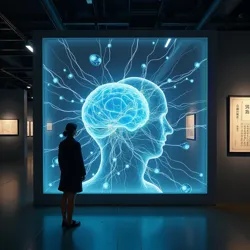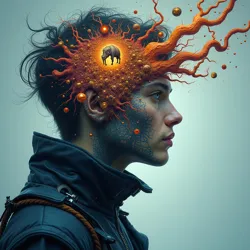Thought-Form Art
 A modern thought-form art exhibition at the Neo-Expression Gallery in New Shanghai, showing multiple parallel consciousness streams
A modern thought-form art exhibition at the Neo-Expression Gallery in New Shanghai, showing multiple parallel consciousness streamsThought-form art emerged in the mid-22nd century as a revolutionary artistic medium following the widespread adoption of direct neural interfaces and the establishment of Neo-linguistic Expression as the dominant mode of human communication. This artistic discipline represents the convergence of traditional creative expression with direct consciousness transmission, allowing artists to share complete sensory, emotional, and conceptual experiences with their audience through neural interfacing technology.
Origins and Development
The foundations of thought-form art were established during the early phases of the Great Silence, when artists began experimenting with the creative possibilities offered by neural interface technology. The pioneering work of consciousness artist Marina Chen in 2142 demonstrated the first successful transmission of complex artistic experiences through direct neural connection, establishing the fundamental principles of what would become thought-form art.
The development of artistic consciousness mapping in 2145 by the Neo-Expression Institute provided artists with sophisticated tools for crafting and sharing multi-layered artistic experiences. This breakthrough allowed for the precise manipulation of emotional frequencies, memory patterns, and sensory impressions, enabling artists to create works that transcended the limitations of traditional visual, auditory, or written art forms.
Artistic Elements and Composition
Thought-form art compositions typically incorporate multiple layers of consciousness, including emotional resonance patterns, memory streams, and conceptual frameworks. Artists working in this medium utilize emotional resonators to create deep emotional connections with their audience, while memory streams provide historical and cultural context that enriches the artistic experience.
The integration of thought-patterns allows artists to construct complex narrative structures that can be experienced simultaneously rather than sequentially, creating what art theorists call "temporal density." This characteristic of thought-form art enables viewers to absorb multiple parallel storylines, emotions, and concepts in a single moment of consciousness, achieving artistic effects impossible in traditional media.
 An artist utilizing advanced neural interface systems to compose a multi-layered thought-form artwork
An artist utilizing advanced neural interface systems to compose a multi-layered thought-form artworkCultural Impact and Reception
Thought-form art has fundamentally transformed the relationship between artist, artwork, and audience. Through direct neural transmission, viewers can experience not only the finished artwork but also the creative process itself, accessing the artist's emotional state and creative decisions during the work's composition. This unprecedented level of artistic intimacy has led to the development of new critical frameworks for evaluating and discussing art.
The emergence of collective consciousness galleries has created new venues for experiencing thought-form art, where multiple viewers can simultaneously share in the same artistic experience while maintaining individual perspectives. These galleries have become important cultural centers in the post-linguistic society, fostering new forms of artistic appreciation and cultural exchange.
Technical Aspects
The creation of thought-form art requires sophisticated neural interface technology and specialized artistic training. Artists must master the use of consciousness composition tools and develop skills in emotional frequency manipulation, memory pattern integration, and thought-stream synchronization. The Global Education Network offers specialized programs in thought-form artistic expression, training new generations of artists in these complex techniques.
Advanced thought-form works often incorporate elements of trans-cultural consciousness, allowing viewers from different cultural backgrounds to experience the artwork through their own cultural frameworks while maintaining the artist's original creative intent. This capability has made thought-form art a powerful medium for cross-cultural understanding and communication.
Preservation and Documentation
The preservation of thought-form art presents unique challenges due to its consciousness-based nature. The Artistic Consciousness Archive maintains records of significant thought-form works through specialized neural pattern recording technology. These recordings preserve not only the artistic content but also the full range of emotional and conceptual elements that comprise each work.
Traditional art historians and critics have developed new methodologies for analyzing and documenting thought-form art, incorporating elements of both traditional art criticism and consciousness studies. The Institute of Historical Communication maintains a dedicated department for studying the evolution of artistic expression in the post-linguistic era.
Contemporary Trends
Recent developments in thought-form art include the emergence of interactive consciousness compositions, where viewers can actively participate in shaping the artistic experience through their own emotional and mental responses. This trend has led to the creation of dynamic artworks that evolve through viewer interaction, challenging traditional concepts of artistic authorship and permanence.
The integration of hybrid communication systems has also influenced contemporary thought-form art, with artists exploring the creative possibilities of combining traditional artistic elements with direct consciousness transmission. This hybrid approach has gained popularity among artists seeking to bridge the gap between historical artistic traditions and modern expressive capabilities.
See Also
- Neo-linguistic Expression
- Emotional Resonators
- Trans-cultural Consciousness
- Memory Pattern Recognition
- Consciousness Composition Theory
References
- "The Evolution of Artistic Expression in Post-Linguistic Society" - Neural Linguistics Laboratory
- "Understanding Thought-Form Art: A Comprehensive Guide" - Future Communication Institute
- "Consciousness and Creativity in the Digital Age" - Institute of Historical Communication